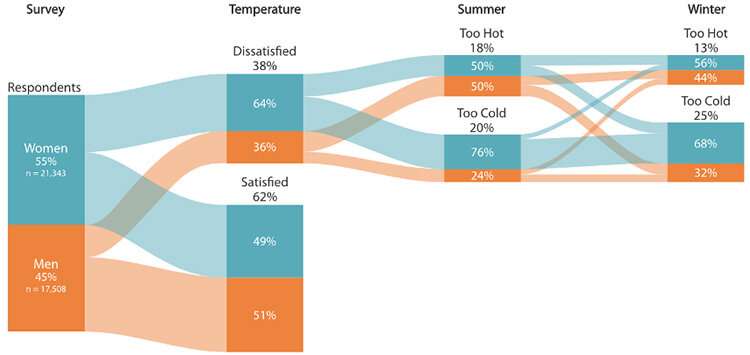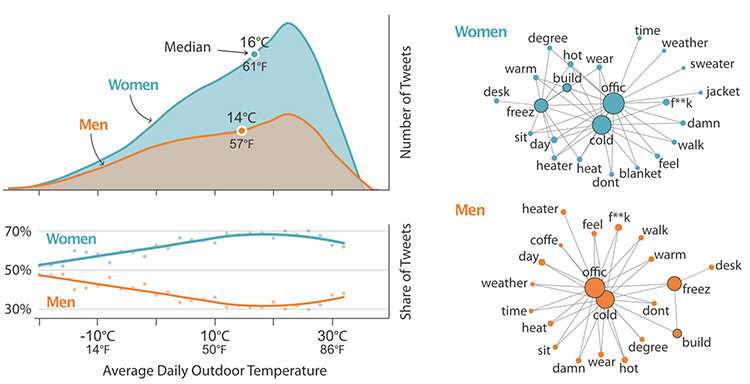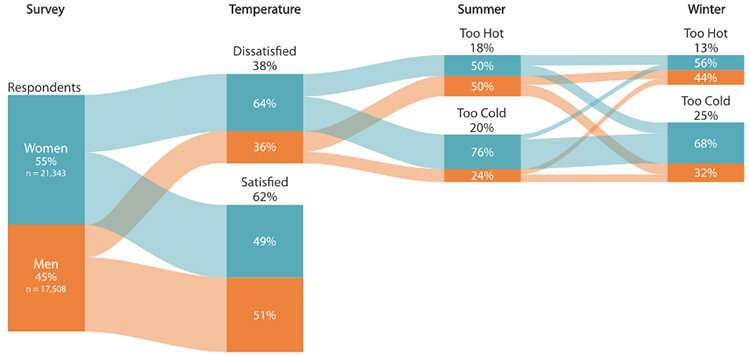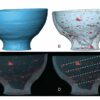Air conditioning systems use vast amounts of energy to maintain comfortable indoor temperatures in offices. This expense is justified by the need for satisfactory indoor environments to ensure the well-being and performance of office workers. Yet our appetite for cooling is growing—air conditioning represents the fastest-growing source of energy use in buildings, with cooling energy tripling between 1990 and 2016.
In our latest study, we found that part of this energy demand is wasted on excessive cooling of offices. This is known as overcooling, where office temperatures are cooled beyond the comfort requirements of occupants. Our results also show that office temperatures are generally less comfortable for women largely due to this overcooling.
We used two large and independent datasets from U.S. buildings to show the prevalence of overcooling and the disproportionate effect it has on women.
First, we analyzed 38,851 responses to the CBE Occupant Survey about satisfaction with temperature from 435 office buildings across 168 cities in the US. Results from the survey show 38% of respondents were dissatisfied with the temperature in their office, far worse than the 20% dissatisfaction limit set in thermal comfort standards.
When these data were broken down by gender, as shown in the figure above, we found that office temperatures were 1.8 times more likely to be dissatisfactory for women than men. Respondents were more likely to report temperatures in summer being too cold. Most dissatisfied occupants had the same response for both seasons, implying sustained cold discomfort year-round.

© Stefano Schiavon
This persistent overcooling disproportionately affected women, particularly in summer when only 24% of complaints of cold temperatures came from men. We also found that more men (44%) reported temperature enhancing their self-reported performance than women (31%).
To complement and expand the analysis beyond our survey, we used crowd-sourced thermal comfort feedback from office building occupants on Twitter.
We collected 16,791 tweets with common expressions of cold discomfort in U.S. offices between January 2010 and December 2019. We used the tweet coordinates to retrieve the average outdoor temperature on the day to explore differences in the relationship between weather and cold complaints. Cold office tweets were common when daily average temperatures were above 20°C, and the majority were from women. The median outdoor temperature was 2.2°C higher for women than men. Furthermore, the likelihood of cold office tweets originating from women increases in warmer temperatures. A breakdown of tweets by region found that overcooling varies slightly with climate, but the unseasonably cold indoor temperatures consistently affect the thermal satisfaction of women more than men.

© Stefano Schiavon
Our findings demonstrate that overcooling is a widespread problem in warm weather in offices across the U.S. The associated impacts of this pervasive overcooling on well-being and performance are borne predominantly by women. These findings corroborate existing evidence of lower thermal satisfaction in offices for women and identify overcooling as a common reason for the gender disparity. The problem is likely to increase in the future due to the growing demand for cooling in increasingly extreme climates.
Increasing temperature setpoints in summer and providing personal comfort systems like fans to people that feel warm may simultaneously increase comfort for all occupants and reduce energy use.
More information:
Thomas Parkinson et al, Overcooling of offices reveals gender inequity in thermal comfort, Scientific Reports (2021). DOI: 10.1038/s41598-021-03121-1
Provided by
University of California – Berkeley
Citation:
Baby it’s cold inside, especially for women in offices (2021, December 13)



